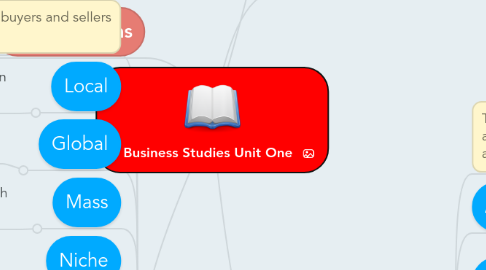
1. Business plans
1.1. Planning what you want to do in your business is an important part of making your business a success.
2. Markets
2.1. A market is any place where buyers and sellers come together
2.2. Local
2.2.1. customers who will buy a product in the region or area in which it is produced.
2.3. Global
2.3.1. selling a product internationally.
2.4. Mass
2.4.1. Un-segmented market in which products with mass appeal products
2.5. Niche
2.5.1. A small but profitable segment of a market suitable for focused attention by a marketer.
2.6. Trade
2.6.1. Commercial transaction involving the sale and purchase of a good, service, or information.
2.7. Consumer
2.7.1. A purchaser of a good or service in retail.
2.8. Market segmentation
2.8.1. The process of defining and subdividing a large homogeneous market into clearly identifiable segments having similar needs, wants, or demand characteristics.
2.8.2. The four basic market segmentation-strategies are based on
2.8.2.1. behavioral
2.8.2.2. demographic
2.8.2.3. psychographic
2.8.2.4. geographical differences.
3. Demand and Supply In the market
3.1. Demand
3.1.1. quantity of a good or service that consumers and businesses are willing and able to buy at a given price
3.2. Supply
3.2.1. The total amount of a product (good or service) available for purchase at any specified price.
3.3. equilibrium
3.3.1. State of stable conditions in which all significant factors remain more or less constant over a period
3.4. Products
3.4.1. Inferior
3.4.1.1. demand declines as the level of income rises
3.4.2. Normal
3.4.2.1. an increase in quantity demanded as the real income of an individual
3.4.3. Luxury
3.4.3.1. means an increase in income causes a bigger % increase in demand.
4. Enterprise
4.1. The process by which new businesses are formed in order to offer products or a service in the market.
4.2. An Entrepreneur
4.2.1. An individual who starts a new business and takes on risks associated with that business
4.3. Motivation
4.3.1. Financial
4.3.1.1. Making a profit
4.3.2. Non Financial
4.3.2.1. Sastifaction
4.4. Characteristics
4.4.1. Motivation
4.4.2. Creativity and Persuasiveness
4.4.3. Versatility
4.4.4. Risk Tolerance
4.4.5. Vision
4.4.6. Flexibility and Open-Mindedness
4.5. SME's In the econmy
4.5.1. Small and Medium Enterprises (SME’s) are the driving force for the promotion of an economy
5. Business strucutre
5.1. Public Sector
5.1.1. the part of an economy that is controlled by the state.
5.1.2. To benefit the community
5.2. Private sector
5.2.1. the part of the national economy that is not under direct state control.
5.2.2. For the owners to make a profit
5.3. Limited liability
5.3.1. the condition by which shareholders are legally responsible for the debts of a company only to the extent of the nominal value of their shares.
5.4. Unlimited liability
5.4.1. liable for all business debts if the business can't pay its liabilities
5.5. Legal Structure
5.5.1. Public limited companies
5.5.1.1. a company registered under the Companies Act, with statutory minimum capital requirements and shares floated on the stock
5.5.2. Private Limited company
5.5.2.1. Shares do not trade on the stock exchange. limited liability
5.5.3. Sole trader
5.5.3.1. One sole owner of a company, Unlimited liability
5.5.4. Parternership
5.5.4.1. 2-20 Partners that own the business. Unlimited Liability
